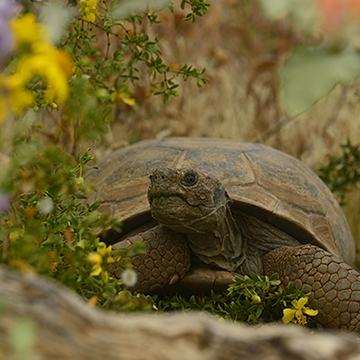What you Need to Know to Adopt a Tortoise
Each year the Arizona Game and Fish Department adopts out hundreds of captive desert tortoises that are surrendered to the department. These tortoises cannot be released back into the wild because captive tortoises can transmit diseases that can decimate our wild population. Desert tortoises are nontraditional pets, but are fascinating animals and families can gain an appreciation of desert wildlife by caring for a tortoise and watching its natural behavior.
Adoption applications are being accepted year round.

Care for a Desert Tortoise
Captive desert tortoise cold weather care
Proper desert tortoise diet
Native Plants for Desert Tortoises: downloadable brochure
Desert tortoise health and illnesses

Tortoise Adoption
Adoption applications are being accepted year round.
Before submitting your adoption application, see the resources below to learn about desert tortoises and what’s required to properly care for one. Adopters should also consider that healthy tortoises can live upwards of 80-100 years and should have a long-term plan in place in either a will or other succession plan as the tortoise may outlive its caretaker.
Application process
Desert Tortoise Adoption Guide
Adoption Guide – Spanish version
Paper application: Desert Tortoise Adoption Application. E-mail the completed application and photos of the tortoise’s constructed habitat and burrow to TAP@azgfd.gov or mail to Tortoise Adoption Program, 5000 W. Carefree Highway, Phoenix, AZ 85086.

Captive Tortoise Shelter
Constructing a desert tortoise enclosure and burrow
*Note: You must complete your burrow and backyard enclosure before submitting your application.

Support Our Tortoise Program
Your donation helps provide essential care for tortoises as they await their forever homes. To contribute, visit the link below, scroll down, open the “Select Cause” dropdown menu, and choose “Tortoise Program.” Together, we can give these remarkable reptiles the future they deserve.

Meet Phil + Tortilla
When Phil Hinson’s son met the desert tortoise, Tortilla, there was no doubt they had an instant connection. During an adoption event with the Arizona Game & Fish Department last year, his son stepped into the enclosure for the first time and Tortilla instantly came running up to him as fast as a tortoise can. She even let him feed her some fresh greens. It was love at first sight.
“My son loves reptiles, and he has always wanted to adopt one.”
Tortilla the Tortuga was instantly welcomed into the family of four, including their two indoor cats (who keep a safe distance!). At an estimated 10-12 years old, Tortilla was put up for adoption by AZGFD in May 2024. Now, she’s a spritely addition to the Hinson family. So, how did she get there?
After learning about the tortoise adoption program through the Phoenix Herpetological Sanctuary, Phil and his wife Lauren began to seriously consider welcoming a wildlife creature into their home. When they had an opportunity to move into a new house with a bigger backyard space, the Hinson family got straight to work on preparations to bring Tortilla home.
Using metal roofing materials and redwood posts, Phil began to construct the habitat per the requirements needed to properly care for a tortoise. This included making sure the metal pieces were placed at least 12 inches deep into the ground so Tortilla wouldn’t be able to dig her way out of her new home. Creating a safe and reliable burrow is key, especially during brumation periods when tortoises become dormant for several months.
Admittedly, Phil described how setting up the habitat is often the hardest part of preparing to care for a desert tortoise. He connected with Jarrod at Arizona Tortoise Tubes for guidance on constructing the burrow. Jarrod supplied a corrugated construction tube nearly four feet long, which is placed underground and subsequently covered in dirt. These sturdy tubes are easy to bury and can be adjusted to accommodate tortoises of all sizes.
“I wanted the burrow to look good and also be safe for Tortilla. I’m not handy at all, so what you see is what anyone can do. Lucky for us, as soon as we brought her back, she found the burrow, went right in, and made herself at home.”
Phil planted native desert plants in the yard, which assist in providing food and shade for Tortilla—an important factor especially during summer months. An existing desert willow tree was a primary reason why the family chose the house as their new home. Not only does it offer protection near Tortilla’s burrow, but she also loves to snack on its flowers!
Naturally, Tortilla eats well. The kids spoil her by bringing her dandelion greens. She enjoys a steady diet of leafy vegetables, blossoms from native plants, weeds like spotted spurge, as well as other grasses like Bermuda. Special treats include some of her favorites: desert globe mallow or grapevine leaves.
In addition to eating, Phil confirmed that Tortilla is living her best life. Her hobbies include a revered love of sunbathing, getting all the good back scratches, napping in the shade, being hand-fed, and, of course, spending time with her best friends: Phil and Lauren’s two young children, Lennon and Hollis.
“Having a desert tortoise has been a great learning experience for the kids. She’s so interesting to watch and easy to care for. We’re grateful for the ability to give Tortilla a loving home.”
Tortoise owners across the state have connected on social media through Facebook groups, a place where owners can swap stories, share advice, and post photos of their reptilian friends. Phil described how there’s nothing else like this close-knit local desert tortoise community. And that one day, his son would like to run a tortoise sanctuary of his own.
Frequently Asked Questions
Frequently asked questions about living with wildlife and desert tortoises.
Should I pick up sick or injured wildlife?
- There is almost NEVER an occasion when you should remove a wild animal from its natural environment.
- It is always better to call a wildlife rehabilitator to remove or assess a wild animal than to do it yourself.
- If you’ve already picked up a young animal, please put it back exactly where you found it, or under/in a shrub nearby where its mother can find it.
Can i adopt more than 1 tortoise?
Per Arizona Game and Fish Commission Order 43, “Possession limit is one desert tortoise per person per household.” AZGFD Rule (R12-4-407) states it is illegal to breed desert tortoises.
I can no longer care for my tortoise. What can I do?
In Arizona, it is illegal to release any tortoise into the wild. Releasing a tortoise into the wild can be detrimental to wild tortoises because it can spread disease and disrupt uniquely adapted genetics in wild populations.
Almost all of the desert tortoises that are available for adoption are previous pets. We understand that situations may arise that may result in you needing to find a new home for your tortoise. If this happens, please call our Desert Tortoise Adoption Program at 844 896-5730 and we can assist in finding a new home.
I found a Tortoise, what do I do with it?
If you are in an open, “wild” area and come across a desert tortoise, chances are it is wild and is just living its life and you should leave it alone. If you observe a potentially injured tortoise or you find a healthy one in a populated area, please call the Desert Tortoise Adoption Program, 844 896-5730 so that we can help make the best decision for that tortoise. It is illegal and detrimental to desert tortoise populations to collect tortoises from the wild.
Can I breed my pet Tortoise?
Breeding captive tortoises is illegal and increases the number of captive tortoises needing adoptive homes, but occasionally an adult female desert tortoise may lay viable eggs from mating years earlier, resulting in tortoise hatchlings in your backyard enclosure. In this case, it is important that they are kept outside so that they can receive sunlight to help develop a healthy shell and bones. Contact the Desert Tortoise Adoption program coordinator as soon as possible if you recently adopted a female desert tortoise and suspect she may be gravid, or is laying eggs, or if you find hatchlings in your backyard and need to surrender them to the adoption program.
I need to move, can I bring my pet tortoise with me?
Tortoises Native to Arizona Must Remain in Arizona.
Under state law, desert tortoises cannot be removed from Arizona so if a tortoise caretaker plans to move from the state or passes away and no succession plan is in place (such as a will), it must be returned back into an approved adoption facility. If the tortoise is relocated within the state, please contact the nearest adoption facility to update the tortoise’s information in our records.
I live in Tucson. Is there an Adoption Center near me?
The Arizona Sonoran Desert Museum (ASDM) is a state sanctioned adoption facility in Tucson. We work closely with our partners at ASDM, you can select your preferred adoption location within the online application.
I CAN’T ADOPT YET. IS THERE ANOTHER WAY TO SUPPORT THE PROGRAM?
To make a donation to the tortoise adoption program, please visit www.azwildlifehero.com/donate and choose “Tortoise Program” from the dropdown menu of causes. We sincerely appreciate your support.
Want to Get Involved with Wildlife Conservation?
Volunteer your time, or donate to help us with conserving and protecting our wildlife. When you purchase a hunting or fishing license online, resources go back into wildlife conservation.
donate to wildlife conservation
With your help, we can continue to conserve & protect Arizona’s wildlife.
volunteer for projects
If you have a passion for wildlife and want to help us conserve and protect it, we’d love to have you on our team!
